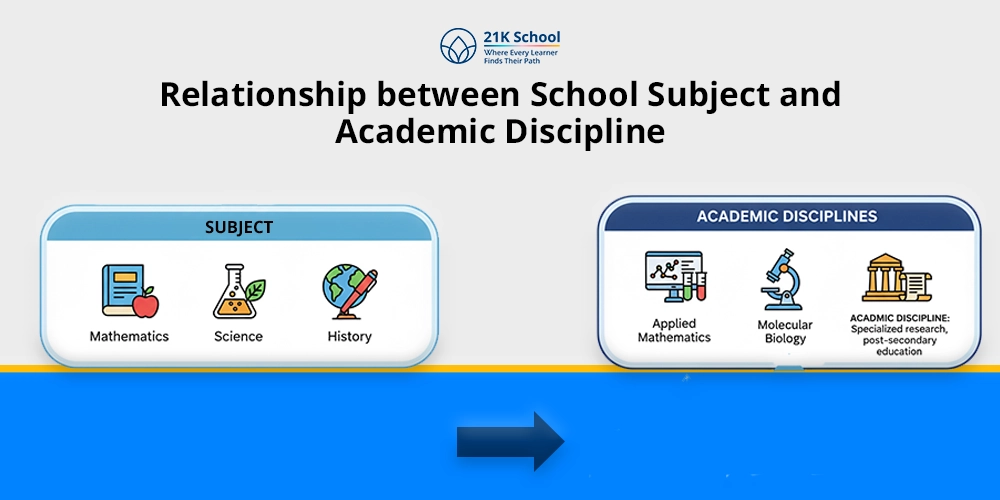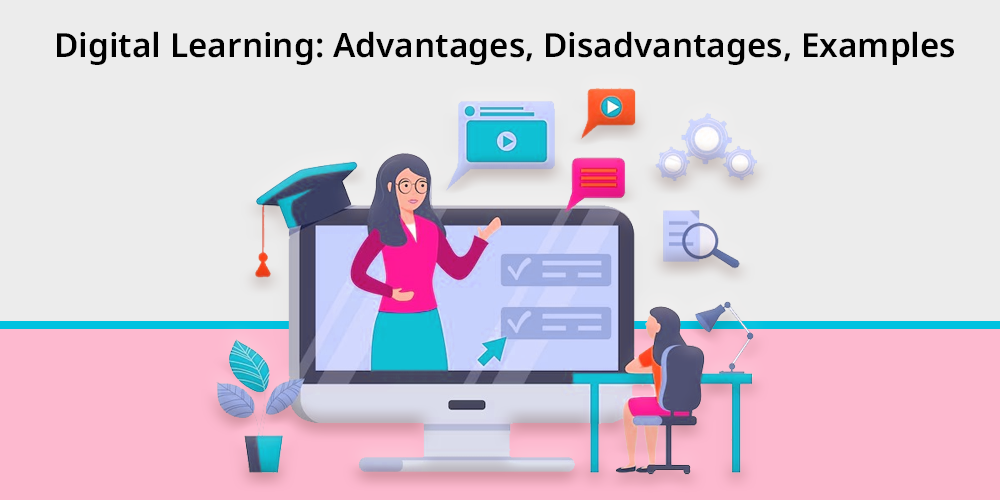
Digital learning, which is also known as online learning or e-learning , is an interactive method of education. Digital learning uses technology in education to enhance the learning experience of students through interactive digital tools.
Digital learning uses various tools, platforms and resources to facilitate the learning process. In digital learning, all the instructions were given to students with the help of technology.
Through digital learning, all the classes and assignments were conducted with the help of the internet and e-learning platforms . With the e-learning evolution , digital education has reached every home, which allows individuals to connect remotely and indulge in online group activities.
Digital education provides students with flexible and personalised education enabling them to enhance their efficiency. With the help of digital learning, students can attend their classes from any location, irrespective of any challenges and hindrances.
This becomes possible with the help of virtual learning platforms such as Zoom, Google Meet, Google Classroom, Microsoft Teams, etc. This enables them to actively engage in collaborative learning.
Contents
What is Digital Learning
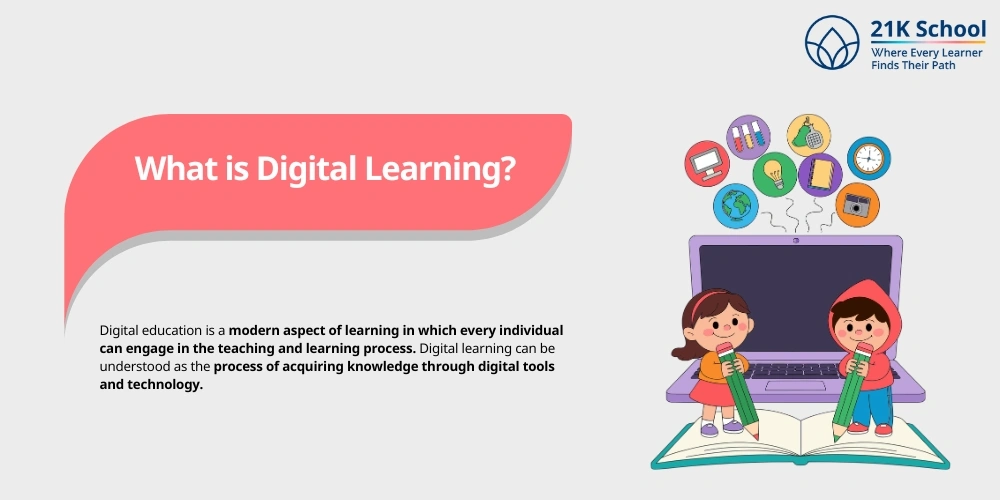
Digital education is a modern aspect of learning in which every individual can engage in the teaching and learning process. Digital learning can be understood as the process of acquiring knowledge through digital tools and technology.
Digital learning is also known as online learning, e-learning, digital classes, etc., that uses technology and software to teach students effectively. Education is not limited only to books and copies, instead, it has changed to a digital aspect of learning using e-books and PDFs.
Digital learning uses electronic mediums such as mobile phones, laptops, and computers in order to transfer knowledge from one place to another, which makes it accessible and cost-effective.
Students can engage in the learning process through fun in learning approaches, as digital education uses interactive methods such as simulations, games, videos, animation, and audio.
The contribution of technology to education makes learning more engaging and impactful. As digital education uses digital mediums to provide courses, notes, study materials, lectures and so on with the help of the internet and software.
Digital classrooms also help students to provide students with flexible and personalised education with the help of virtual learning platforms .
Various online schools and platforms, such as 21K School , K8 school, Vedantu, Khan Academy, etc., also use digital learning as a prime factor for teaching and learning.
Importance of Digital Learning
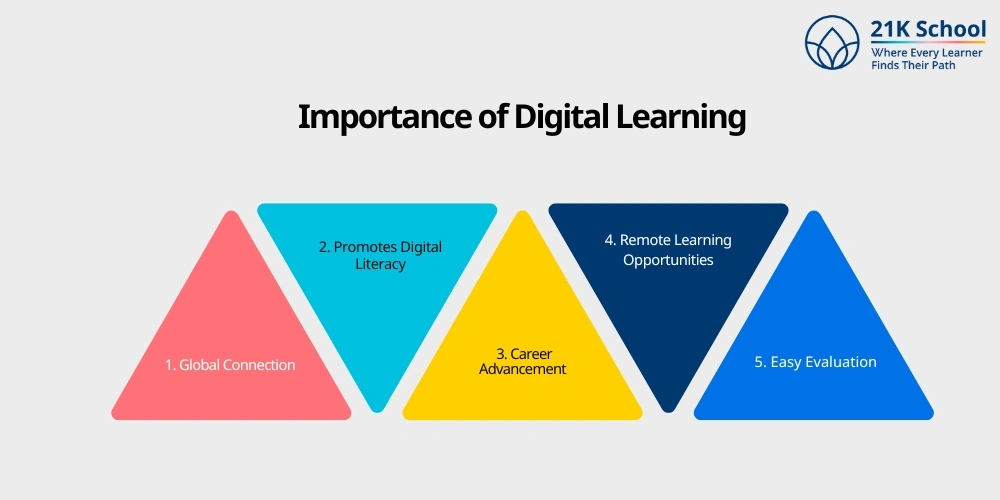
Digital learning plays an integral role in making education more interactive and engaging. With the help of the implementation of technology, digital learning becomes more accessible and cost-efficient.
Digital learning allows and attention through digital tools. Here, you can refer to the importance of digital learning.
1. Global Connection
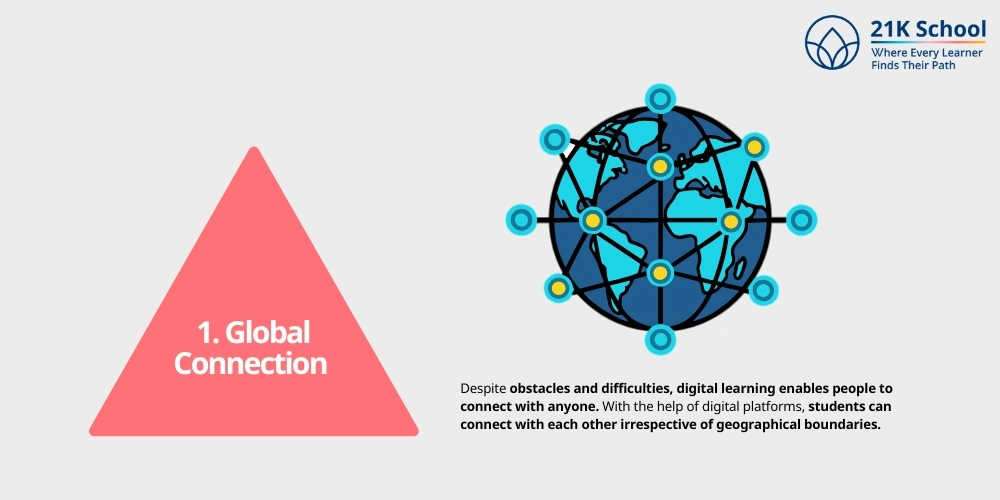
Despite obstacles and difficulties, digital learning enables people to connect with anyone. With the help of digital platforms, students can connect with each other irrespective of geographical boundaries.
The benefits of collaborative learning allow students to develop social skills and enhance their future career opportunities.
2. Promotes Digital Literacy
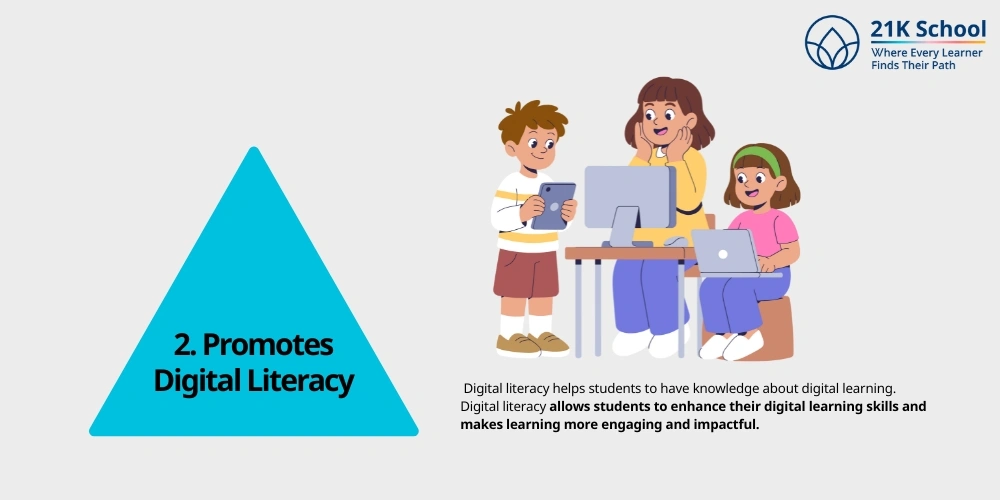
In modern education , digital literacy is the most important aspect. Digital literacy helps students to have knowledge about digital learning. Digital literacy allows students to enhance their digital learning skills and makes learning more engaging and impactful.
Digital literacy is not only limited to academics but is also essential for workplaces, which enhances technical skills among individuals.
3. Career Advancement
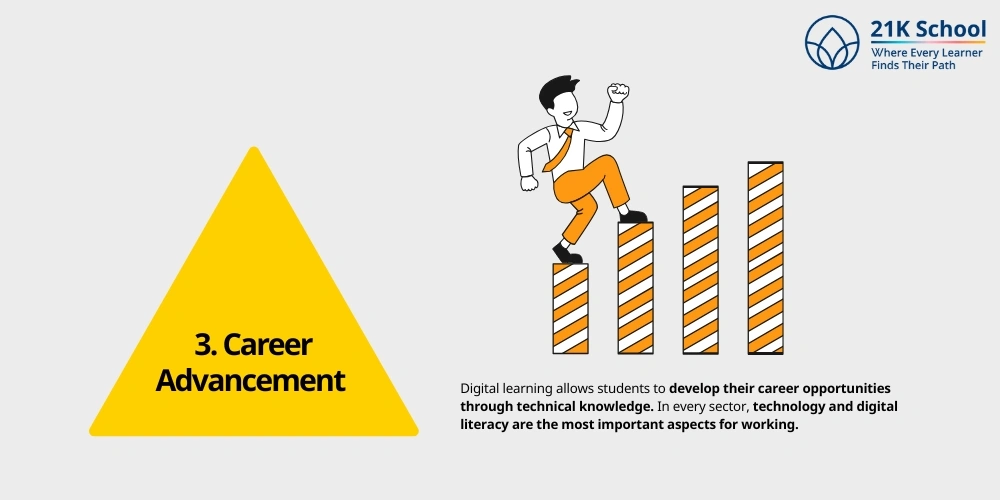
Digital learning allows students to develop their career opportunities through technical knowledge. In every sector, technology and digital literacy are the most important aspects for working.
Through digital learning, students acquire various technical aspects and enhance their learning efficiency, which is essential for acquiring future jobs. This enables students to acquire skills and collaborate with others, which allows them to advance their career opportunities.
4. Remote Learning Opportunities
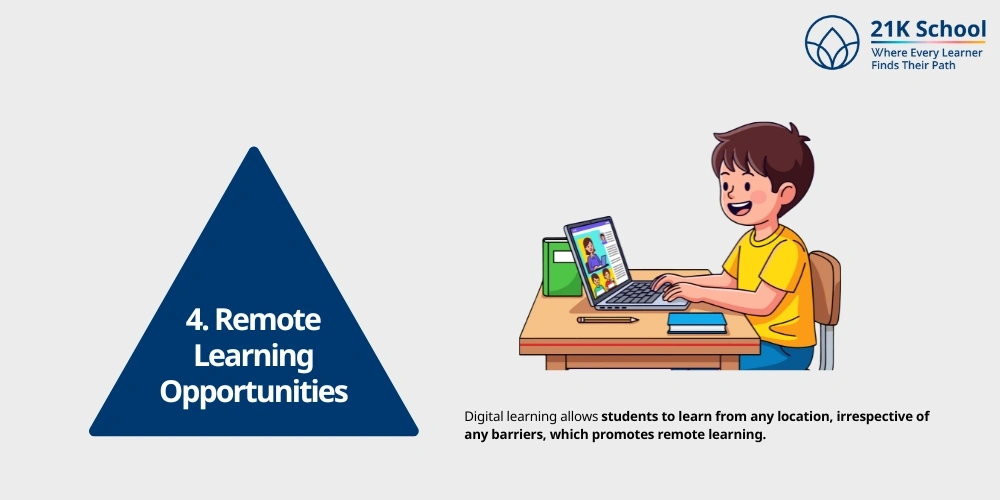
Digital learning allows students to learn from any location, irrespective of any barriers, which promotes remote learning. The benefits of remote learning allow students to learn from their own home at their own comfort and learning speed.
Through digital learning, students can access equal and transparent education irrespective of geographical boundaries.
5. Easy Evaluation
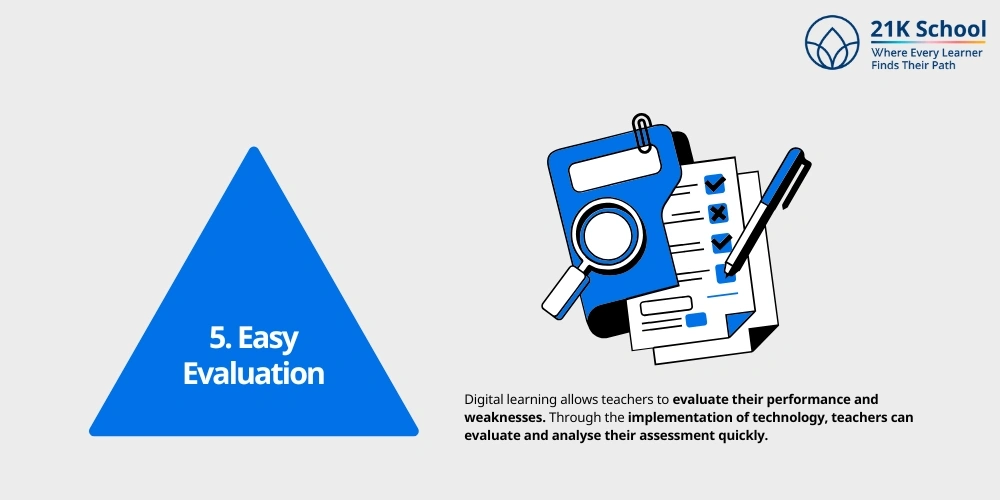
Digital learning allows teachers to evaluate their performance and weaknesses. Through the implementation of technology, teachers can evaluate and analyse their assessment quickly.
This also helps students to understand their strengths and weaknesses which allows them to perform well in their academics.
Types of Digital Learning
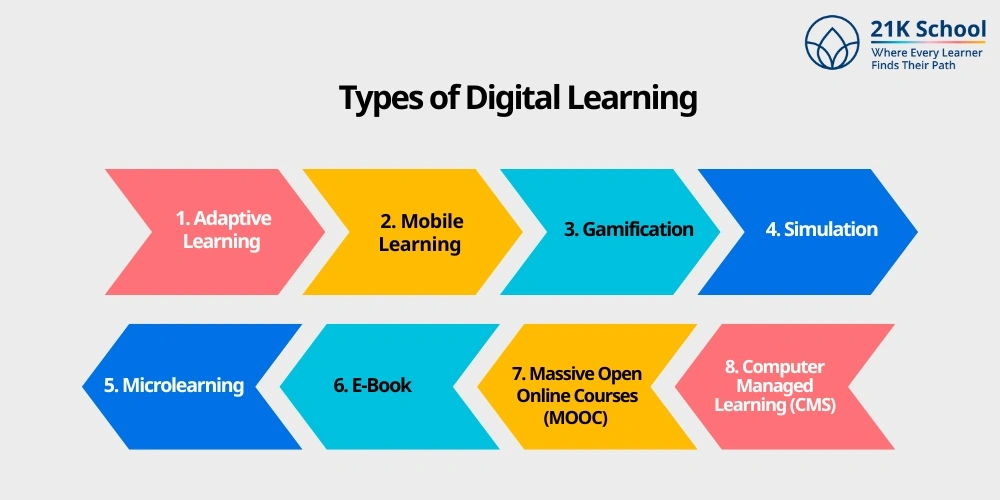
Digital learning uses technology to enhance the learning experience of students. These technologies use interactive methods to engage students and make education simpler and effective.
These tools use various types of learning methods and techniques in order to provide smooth learning opportunities.
Technological aspects are dynamic in nature and can be updated as per the need and evolution, which promotes dynamic education and equips individuals with technological advancements. Here you can check the types of digital learning mentioned below.
1. Adaptive Learning
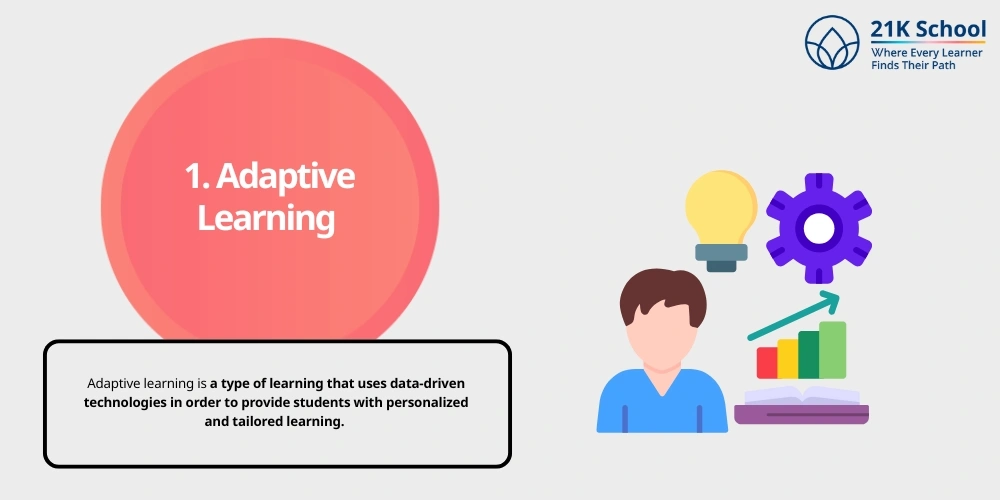
Adaptive learning is a type of learning that uses data-driven technologies in order to provide students with personalized and tailored learning. Adaptive learning uses digital systems in order to maintain students’ records as well as provide them with flexible and customised education.
Through adaptive learning, educators can track students’ data, progress reports and performance. Through adaptive learning, students can understand their weaknesses and progress, which also assists students in providing a systematic delivery of content.
2. Mobile Learning
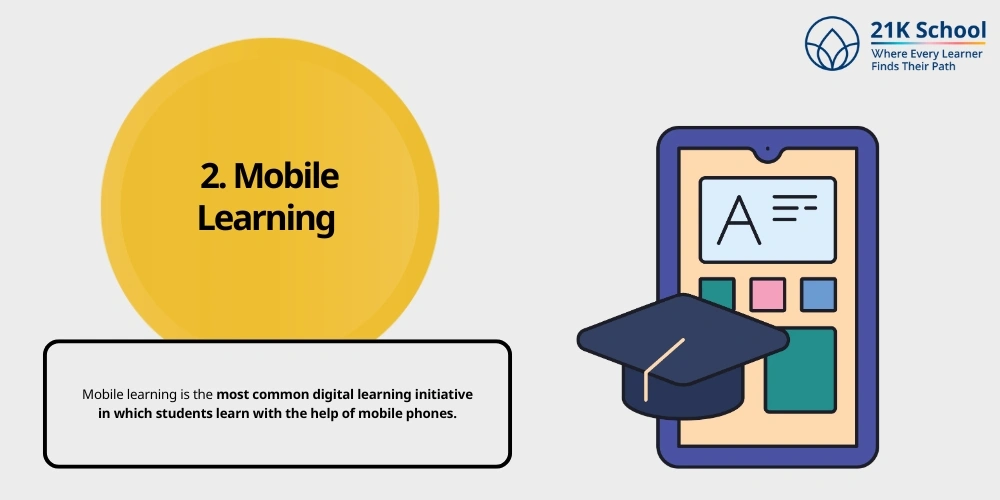
Mobile learning is the most common digital learning initiative in which students learn with the help of mobile phones. Mobile learning, also known as m-learning, is an easy way of acquiring knowledge through the contribution of technology in education .
This enables every student to indulge in live or recorded classes or gain any information at any time any anywhere. M-learning offers mobility and flexibility through which students can study at their own pace, which helps in improving their knowledge retention.
3. Gamification
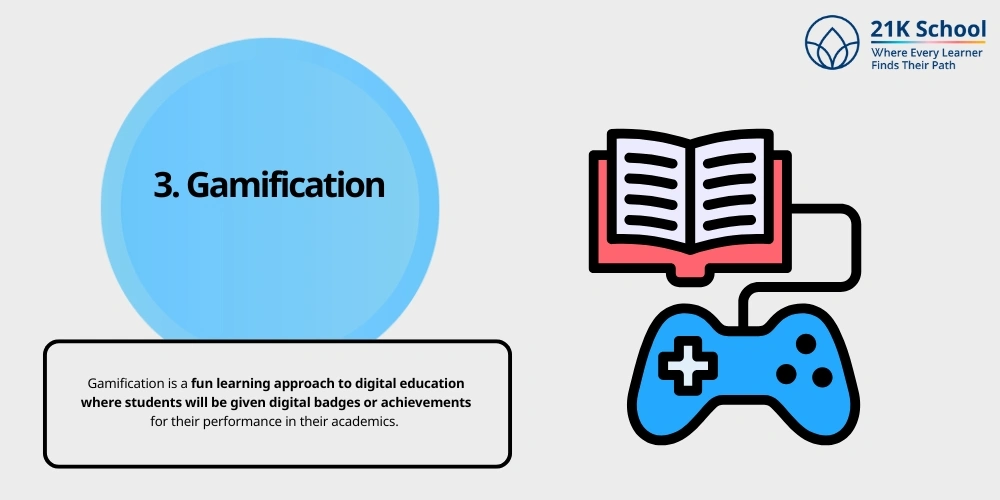
Gamification is an interactive method of learning in which students learn through gaming concepts. Gamification is a fun learning approach to digital education where students will be given digital badges or achievements for their performance in their academics.
Through gamification, students become motivated and which enhances knowledge retention and boosts their confidence. Gamification includes various activities and assessments which allow students to engage in class activities and enhance their performance.
4. Simulation
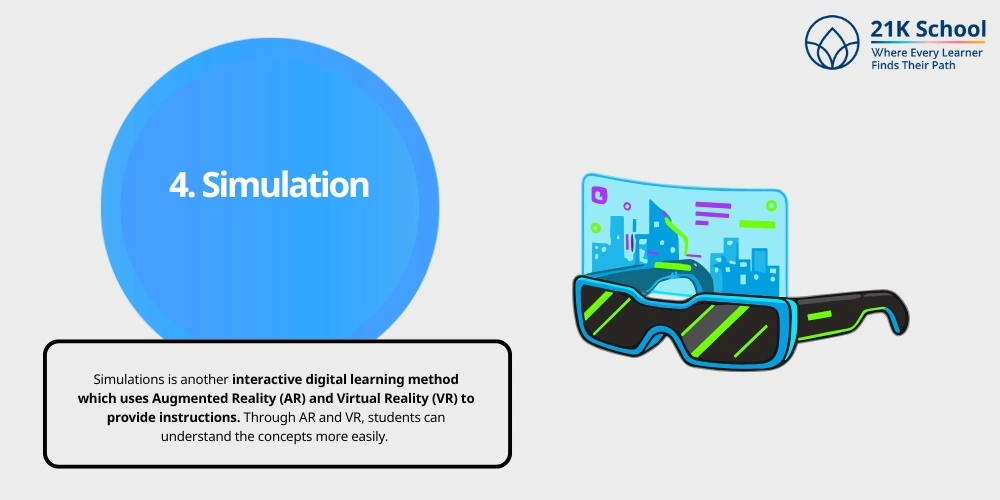
Simulations is another interactive digital learning method which uses Augmented Reality (AR) and Virtual Reality (VR) to provide instructions. Through AR and VR, students can understand the concepts more easily.
This uses simulations using 3D elements to make learning simpler and understandable. VR and AR are interactive ways of grasping practical knowledge , which assist students in order to get hands-on experience and explore the possibilities.
This technique helps in enhancing problem-solving skills and allows individuals to feel the real scenario from their home setting.
5. Microlearning
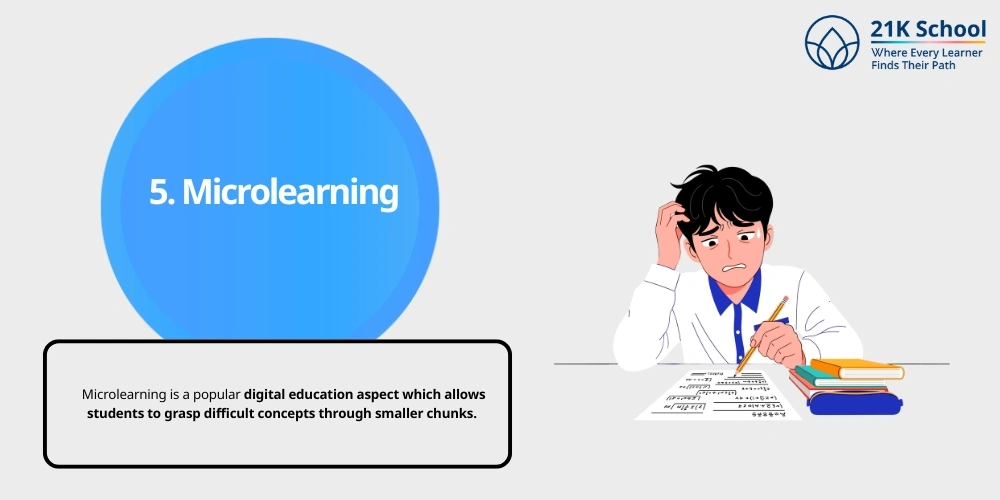
Microlearning is a popular digital education aspect which allows students to grasp difficult concepts through smaller chunks.
In this aspect, larger concepts were broken down into small, understandable concepts, which allows individuals to grasp the information in a simpler way.
Microlearning uses short texts, infographics, messages, quizzes and videos to make difficult concepts simpler and understandable. This method enhances students’ critical thinking skills and promotes their memory retention, which aids them in retaining information for a longer period of time.
6. E-Book
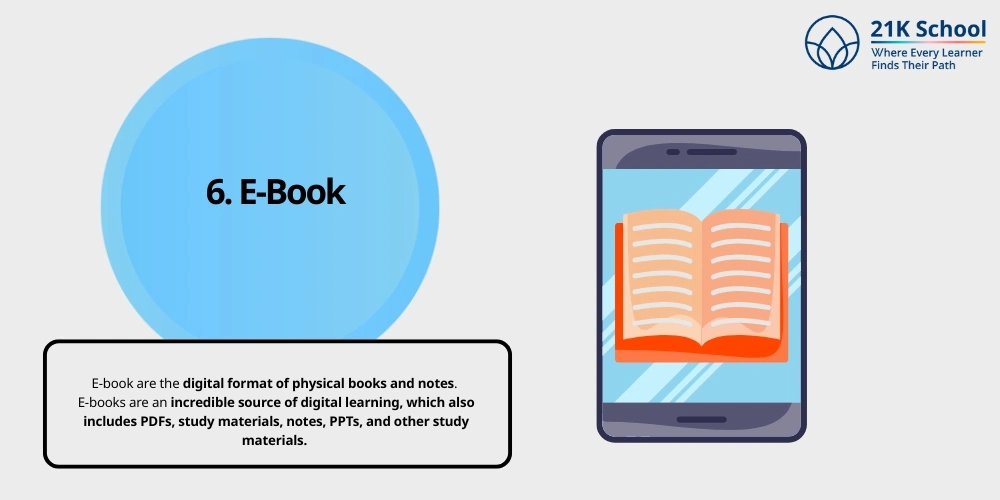
E-book are the digital format of physical books and notes. E-books are an incredible source of digital learning, which also includes PDFs, study materials, notes, PPTs, and other study materials.
E- books help in eliminating the cost of physical books and traditional learning problem-solving , through which students can access any learning materials from any location, irrespective of any challenges.
E-books help in making learning more simpler and effective as compared to physical books. This allows students to enhance their reading habits and promotes a positive learning environment .
7. Massive Open Online Courses (MOOC)
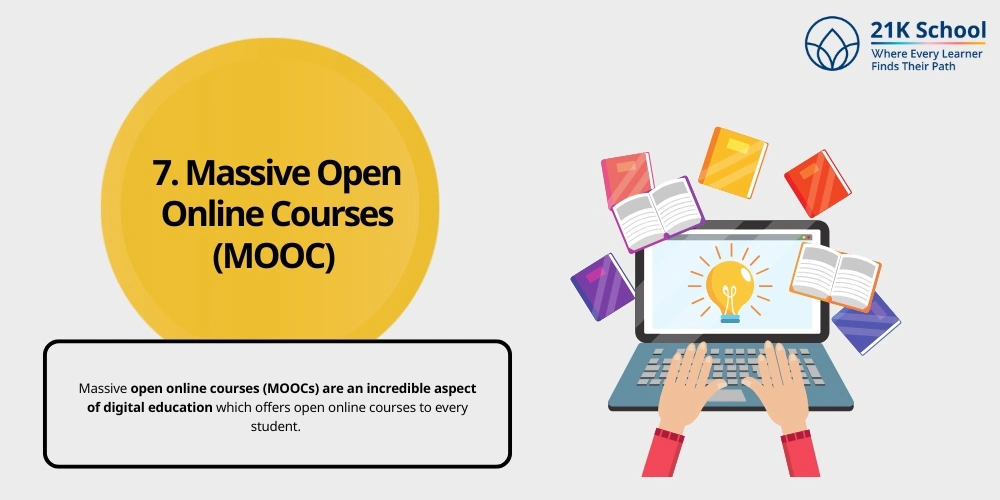
Massive open online courses (MOOCs) are an incredible aspect of digital education which offers open online courses to every student. These courses are primarily free and provided through free platforms and websites such as Google, Facebook, LinkedIn and other websites.
These online courses have pre-recorded videos and animations which allow individuals to study at their own pace. This provides students with easy access to information and resources, which allows them to develop social emotional learning .
8. Computer Managed Learning (CMS)
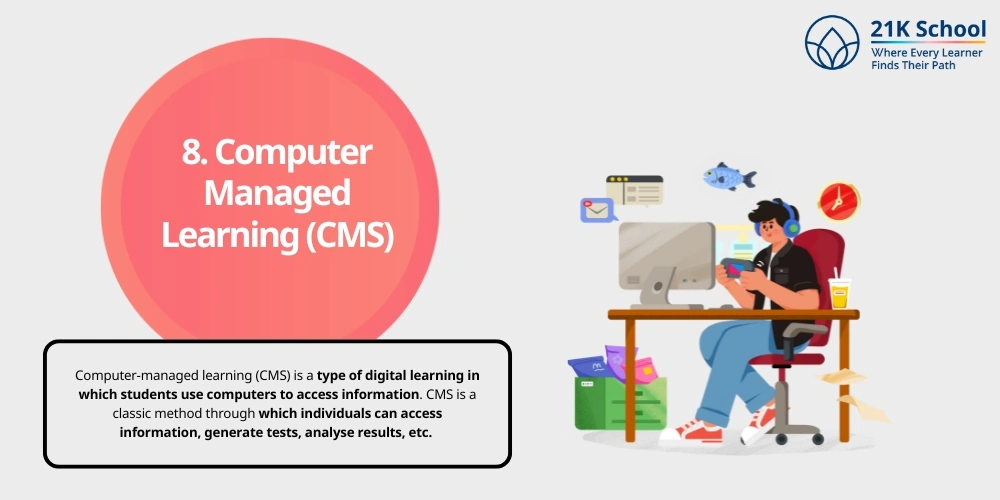
Computer-managed learning (CMS) is a type of digital learning in which students use computers to access information. CMS is a classic method through which individuals can access information, generate tests, analyse results, etc.
The system software of CMS allows a personalized learning approach to students. This method makes learning more interactive and enhances learning methods.
Advantages of Digital Learning
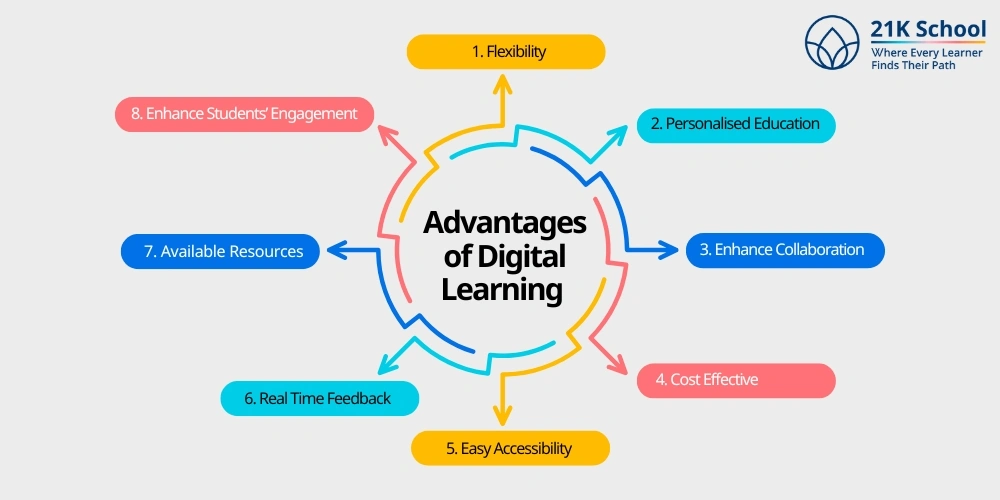
Digital learning promotes inclusive education as well as dynamic education. Digital education helps in promoting collaborative learning environments and enhances digital literacy among children.
As compared to traditional schooling , digital education allows students to develop creative thinking skills and make them socially active.
Digital learning is not only limited to students but is also helpful for teachers, which enhances their teaching method and assessment abilities. The following list of benefits of digital learning can be seen here.
1. Flexibility
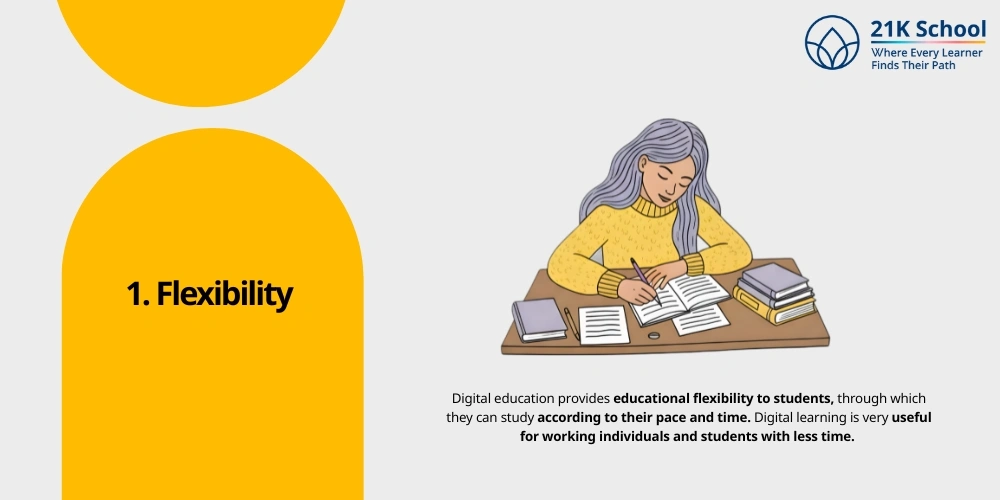
Digital education provides educational flexibility to students, through which they can study according to their pace and time. Digital learning is very useful for working individuals and students with less time.
Flexibility of education allows individuals to engage in the teaching and learning process according to their study routine and comfort level.
Digital learning makes sure that every student receives equal and timely education that matches their schedule, irrespective of any challenges. This enhances the benefits of inclusive education and meets the diverse needs of every child.
2. Personalised Education
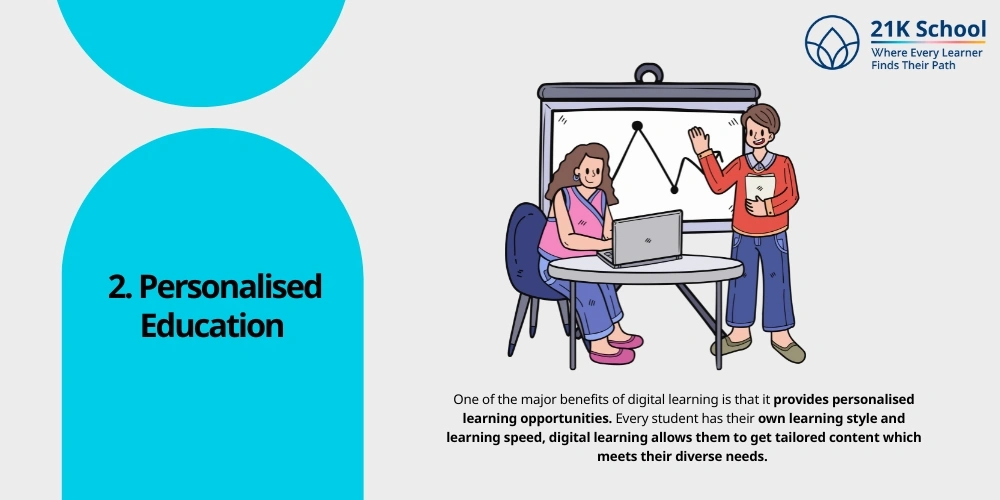
One of the major benefits of digital learning is that it provides personalised learning opportunities. Every student has their own learning style and learning speed, digital learning allows them to get tailored content which meets their diverse needs.
Personalised education allows students to understand the weaknesses and strengths of their concepts. Digital learning uses e-learning platforms which allow students to study as per their needs with the help of one-to-one classes.
This enhances confidence and motivates them to perform well in the examination.
3. Enhance Collaboration
Digital learning helps students to connect with each other at any time, irrespective of geographical boundaries.
This promotes a collaborative learning environment among students through online group projects , discussion boards, activities, experiments and project-works.
Collaborative learning allows students to promote peer to peer education and makes the learning process more engaging, which also allows students to promote cultural awareness .
With the help of online platforms, students can share their ideas, viewpoints, thoughts, concepts, emotions, knowledge, etc.
4. Cost Effective
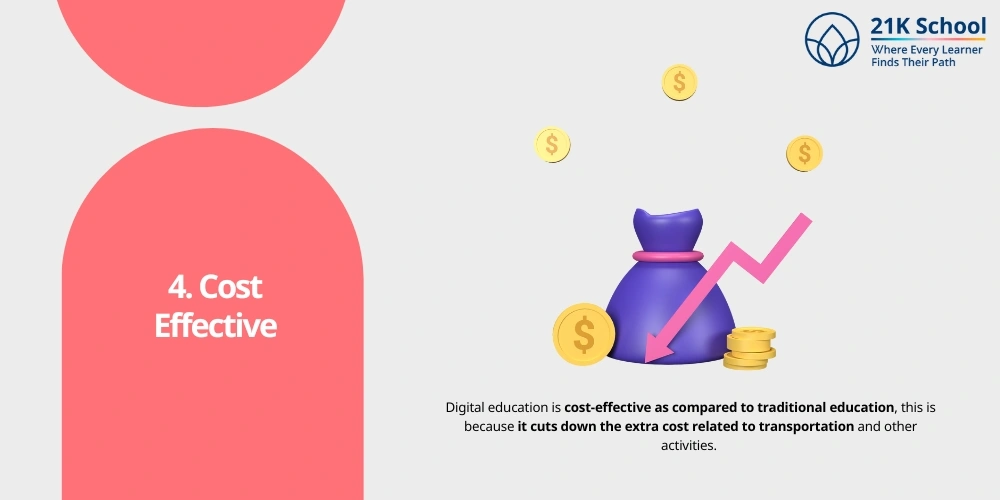
Digital education is cost-effective as compared to traditional education, this is because it cuts down the extra cost related to transportation and other activities.
With the help of digital learning, students can study from their own homes without moving to any location, which helps in reducing costs and expenses.
In physical schools, students have to pay transportation costs, hostel fees, dormitory fees, meals, and other extra expenses. In online schools, students don’t have to pay any extra costs related to travelling and food, which helps them to cut down their expenses.
5. Easy Accessibility
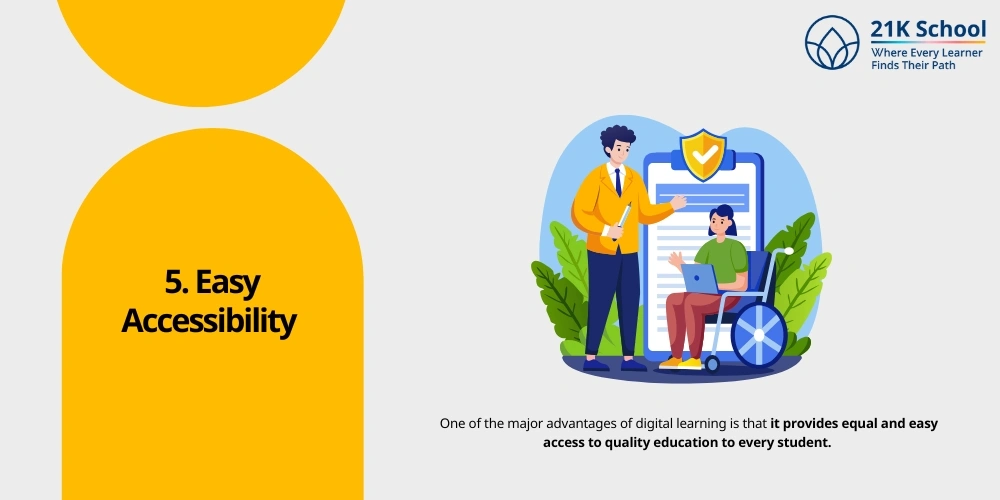
One of the major advantages of digital learning is that it provides equal and easy access to quality education to every student.
With the help of online platforms, students can receive their classes from their home setting, irrespective of geographical boundaries or any hindrances. Students who reside in remote areas and are unable to attend physical schools will benefit from online learning .
As remote learning has easy access to reach every place, and ensures that every student will receive equal and quality education.
6. Real Time Feedback
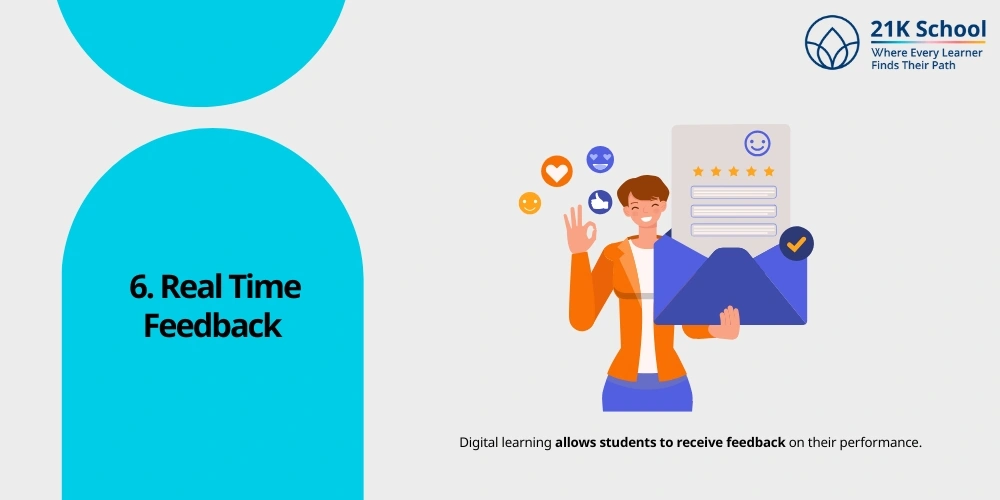
Digital learning allows students to receive feedback on their performance. Through formative assessment tools teachers can effectively conduct real-time feedback, which allows them to understand their performance and weaknesses, through which students can solidify their weak subjects.
This also assists teachers in changing their teaching methods according to students ‘ needs and performance. Real-time feedback allows students to enhance their learning outcomes and improve their academic performance.
7. Available Resources
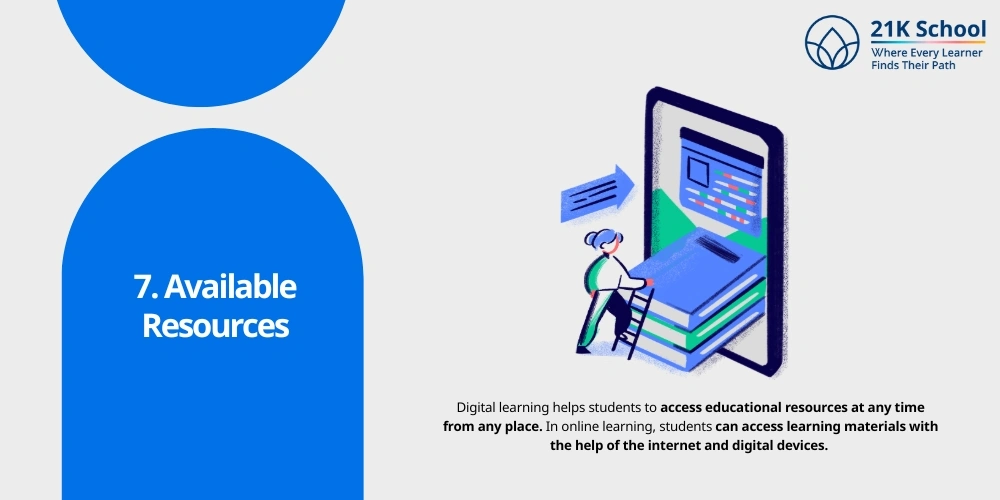
Digital learning helps students to access educational resources at any time from any place. In online learning, students can access learning materials with the help of the internet and digital devices.
They can access resources such as E-books, PDFs, documents, PPTs and other study materials that allow them to learn as per their comfortability. This promotes self-directed learning and encourages them to understand real-life concepts.
8. Enhance Students’ Engagement
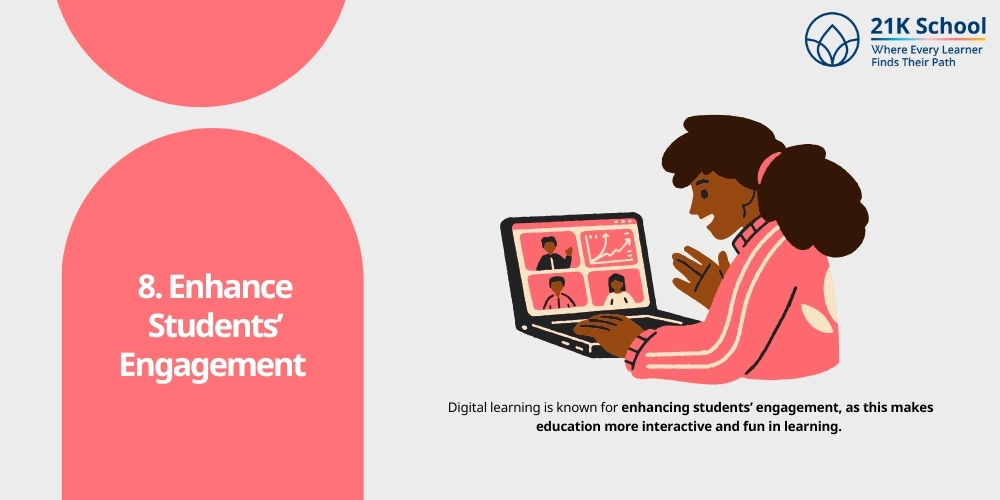
Digital learning is known for enhancing students’ engagement , as this makes education more interactive and fun in learning.
Online learning uses digital formats such as games, videos, animation, simulations, and audio, allowing students to make learning simpler and aiding them in grasping concepts more effectively.
This promotes life-long learning and allows students to enhance their knowledge retention, which makes learning more enjoyable.
Disadvantages of Digital Learning with Solutions
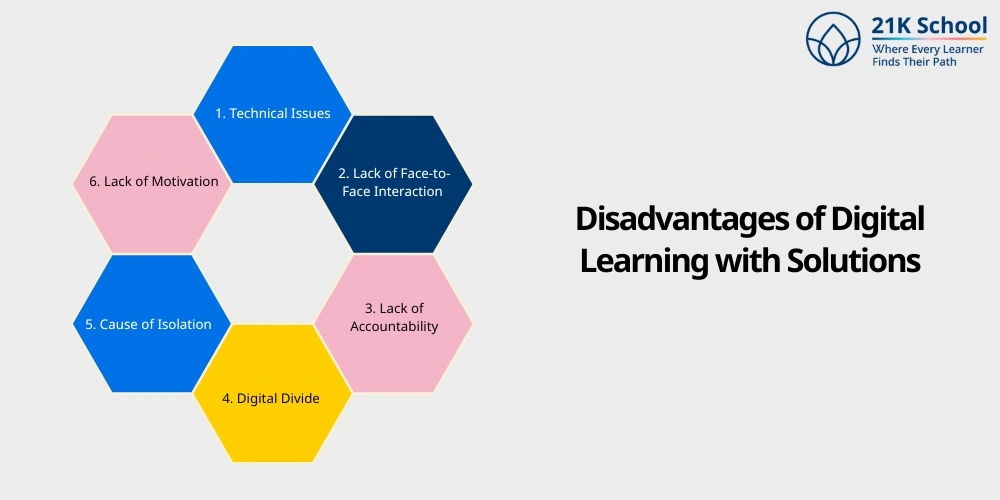
Digital learning enhances students’ academic performance and allows them to enhance their learning efficiency.
There is no doubt that digital education has lots of benefits; however, it still has lots of disadvantages that hinder its true potential of making education more impactful.
Due to the disadvantages of digital learning, students find it difficult to engage in the teaching and learning process. Here you can check the disadvantages of digital learning, with effective solutions.
1. Technical Issues
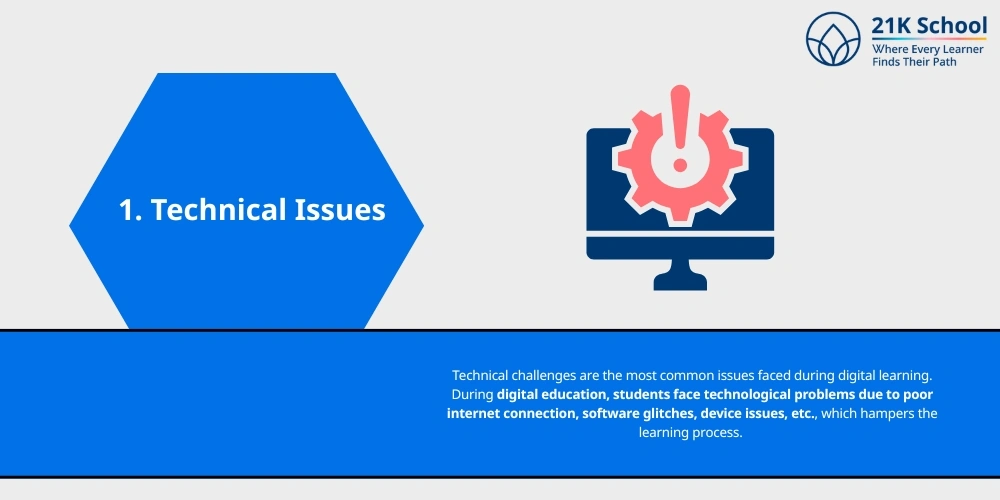
Technical challenges are the most common issues faced during digital learning. During digital education , students face technological problems due to poor internet connection, software glitches, device issues, etc., which hampers the learning process.
Even in rural areas and small cities, students find it difficult to engage in online learning due to poor internet connection and unavailability of learning devices.
Solution to Tackle Technical Challenges
This is a common problem and can occur at any time, however, this problem can be overcome by using a high-speed internet connection, such as WiFi or a modem.
Students can use smartphones to engage in the learning process, as most of the learning platforms are mobile-friendly. Even 21K School, an online school, also uses mobile-friendly software, so that students can learn from their phone.
Even the video platform of 21K School consumes less data as compared to other high-level video platforms.
2. Lack of Face-to-Face Interaction
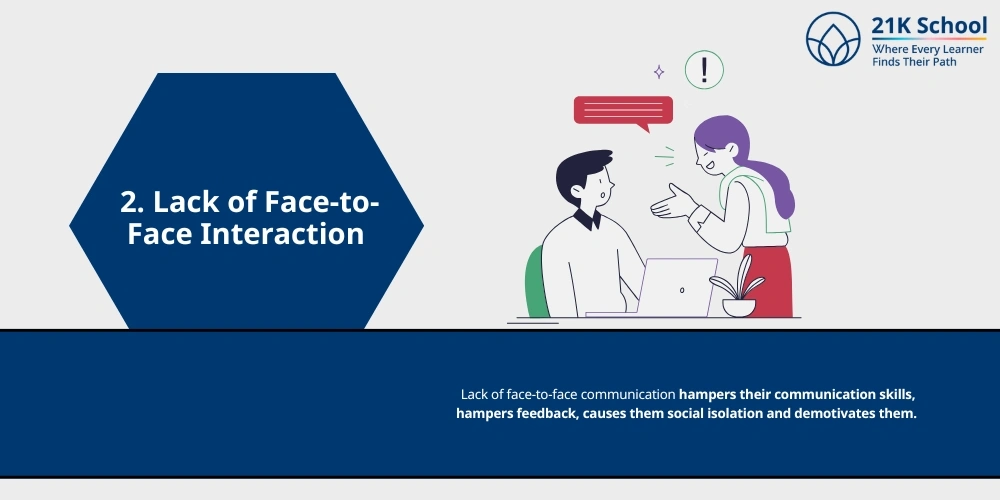
Lack of in-person interaction is the most frequent issue with digital learning that hinders students’ learning.
Lack of face-to-face communication hampers their communication skills , hampers feedback, causes them social isolation and demotivates them. This problem hampers students’ mental health and makes them demotivated, which hampers students’ learning outcomes.
Solution to Tackle Lack of Face-to-Face Interaction
A solution to the issue of in-person interaction is the use of video learning platforms, which allow students to successfully communicate with their peers and teachers.
Implementation of video chats, discussion boards, and chat rooms helps students to cooperate with others. 21K school also uses video platforms and chat rooms in order to provide students with face-to-face interaction and make learning more engaging.
3. Lack of Accountability
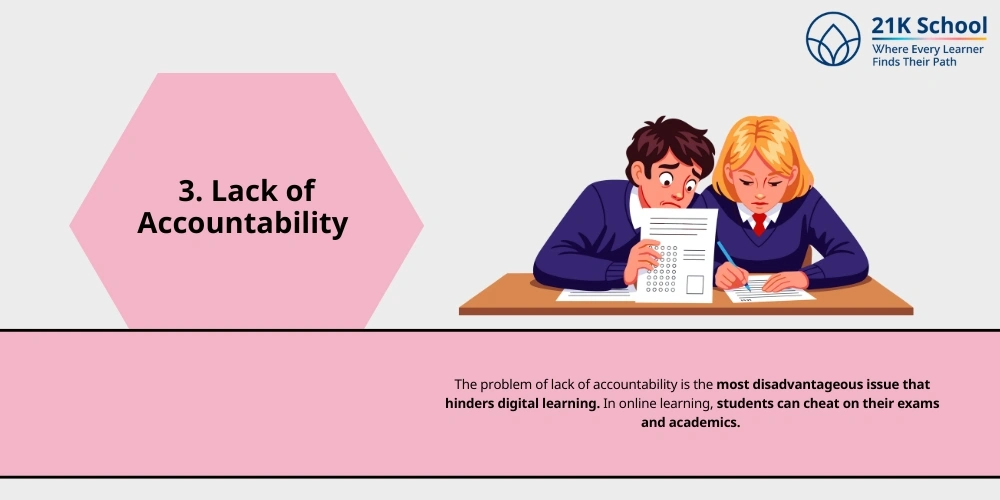
The problem of lack of accountability is the most disadvantageous issue that hinders digital learning. In online learning, students can cheat on their exams and academics.
Lack of accountability is one of the main problems with online learning which affects both students and teachers. Lack of accountability in online learning complicates things and undermines the credibility process.
Solutions for Lack of Accountability
The problem of a lack of accountability can be resolved by implementing anti-cheating measures such as auto-proctoring systems. Even 21K School also uses an auto-proctoring method to conduct examinations, which helps in preventing cheating and maintaining students’ accountability.
4. Digital Divide
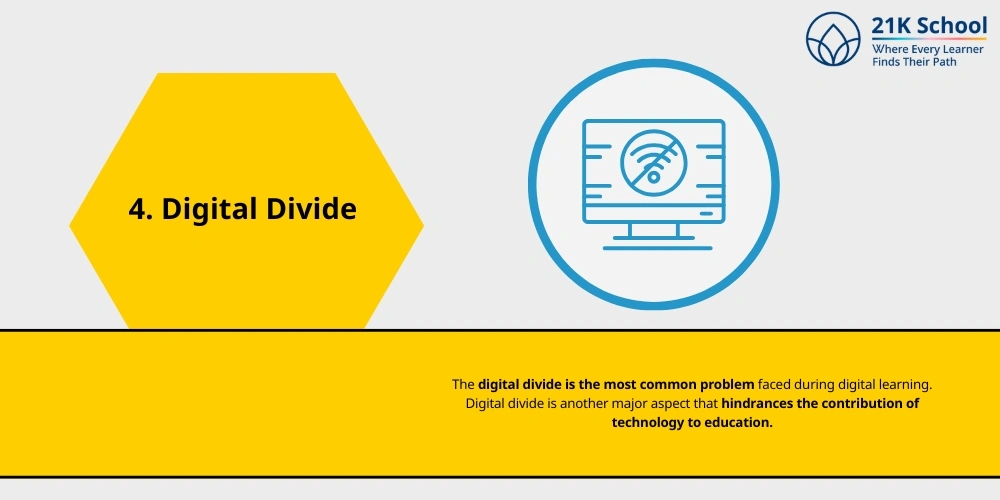
The digital divide is the most common problem faced during digital learning. Digital divide is another major aspect that hindrances the contribution of technology to education. Due to the digital divide, students don’t get equal access to technologies such as the internet, computers, mobile phones, and other technologies.
The digital divide creates a learning gap between individuals and technology and hinders them from utilising it. Digital divide occurs due to various reasons such as lack of digital literacy, governmental rules, economic factors, and so on.
Solution to Tackle Digital Divide
The problem of the digital divide can be overcome by providing equal access to technology to every individual. This problem can be avoided by enhancing digital literacy, making technology affordable, easy accessibility of technology, etc.
These strategies help in implementing technology into education and workplaces. 21K School also helps in providing equal access to educational materials through implementing technological aspects in education.
5. Cause of Isolation
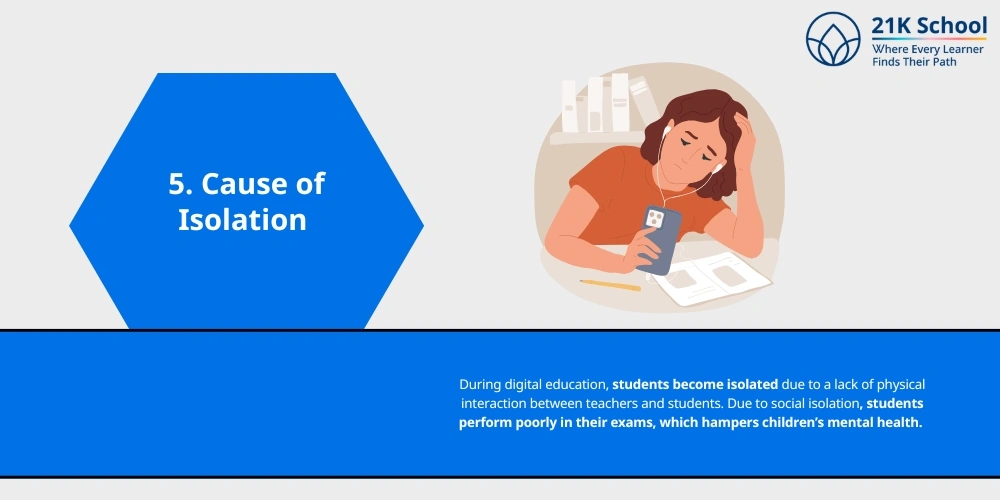
During digital education, students become isolated due to a lack of physical interaction between teachers and students. Due to social isolation, students perform poorly in their exams, which hampers childrens’ mental health .
This causes them to develop exam stress and hampers their communication skills. Spending more time attending online classes hampers physical interaction, which hinders the interaction between teachers and students as well.
Solution to Tackle the Cause of Isolation
This problem can be avoided by making blended learning strategies which allow students to work in both physical as well as online classes. Even using video platforms and interacting with students also helps in tackling the problem of isolation.
21K School also focuses on blended learning techniques, where students can gain practical and digital skills. They even use video platforms and interact with students and parents in order to make classes more interactive.
6. Lack of Motivation
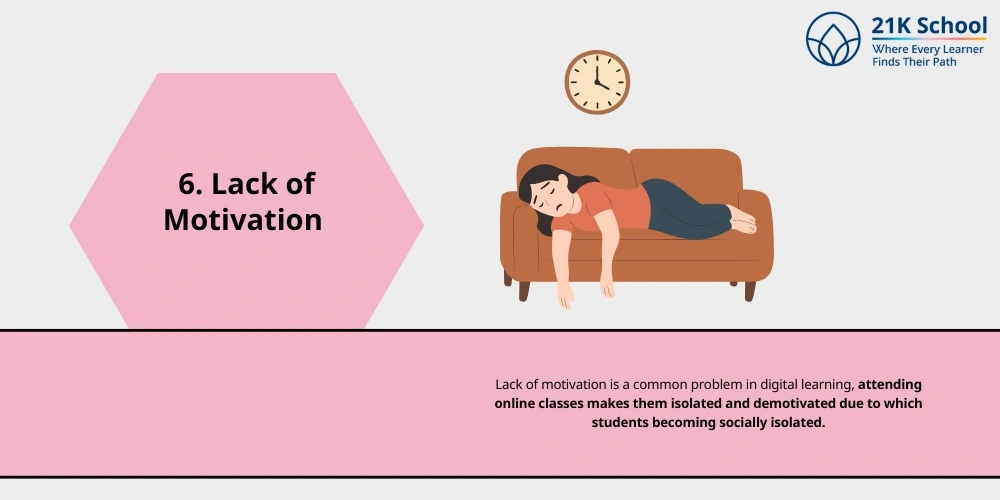
Lack of motivation is a common problem in digital learning, attending online classes makes them isolated and demotivated due to which students becoming socially isolated. Motivation is the prime factor in making the class more interactive and engaging.
Demotivation causes students to perform poorly in the examination, which hampers their study progress and hampers their social skills.
Solution to Tackle Lack of Motivation
The problem of motivation can be avoided by making the class more interactive and engaging. It is also necessary to make face-to-face interaction and motivate students to perform well in their academics.
21K school also motivates their students to perform extremely well as well they also focus on skill enhancement activities, which makes them motivated.
Digital Learning Examples
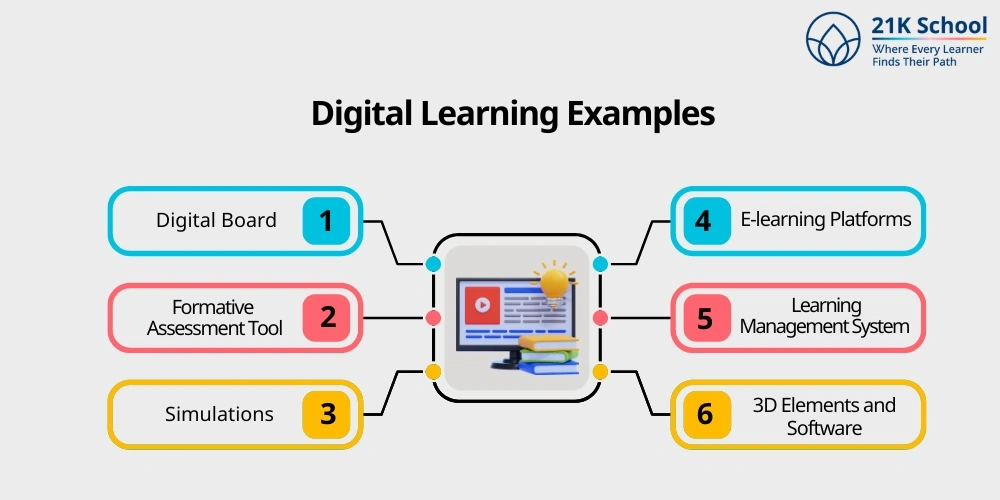
Digital classes are conducted with the help of virtual learning platforms that use some tools to provide learning. Digital tools use various approaches and formats of learning tools that make learning easy and interactive.
These digital tools are prone to update and can be updated over time, which enhances the learning experience of students and teachers. Here you can refer to the examples of digital learning.
1. Digital Board
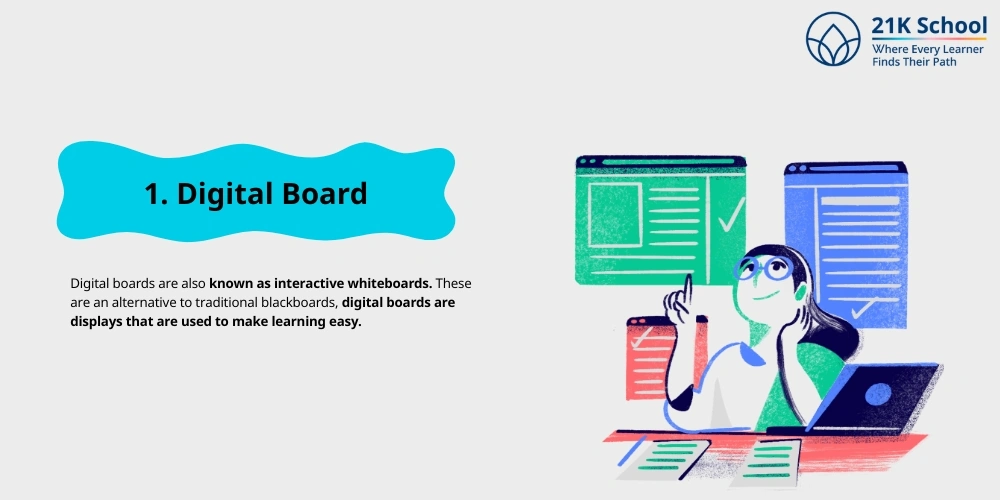
Digital boards are also known as interactive whiteboards. These are an alternative to traditional blackboards, digital boards are displays that are used to make learning easy. With the help of digital boards, teachers can teach their students with animations, stories, colour pictures and videos which make the learning process more engaging and interactive.
2. Formative Assessment Tool
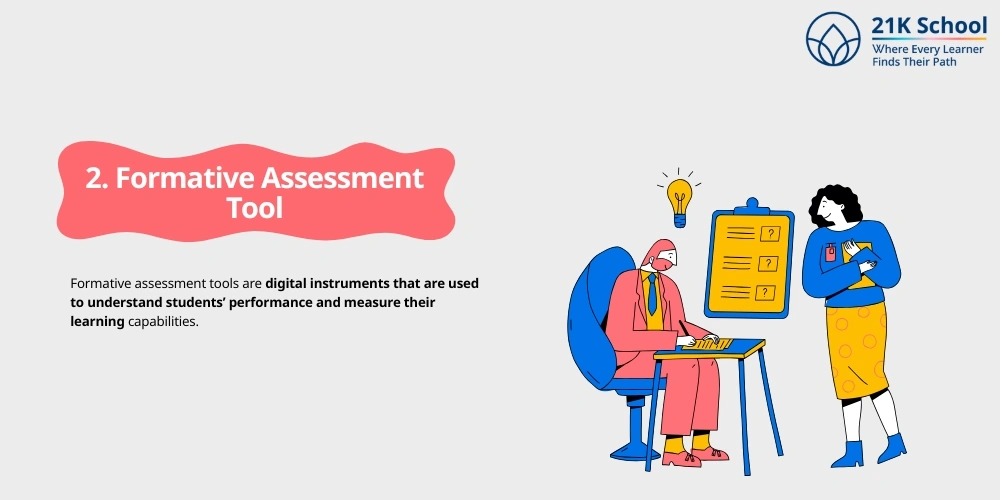
Formative assessment tools are digital instruments that are used to understand students’ performance and measure their learning capabilities. Formative assessment tools are vital for digital education.
Through formative assessment tools, teachers and students can enhance their teaching and learning strategies. This helps in providing feedback and allows students to evaluate their own abilities.
3. Simulations
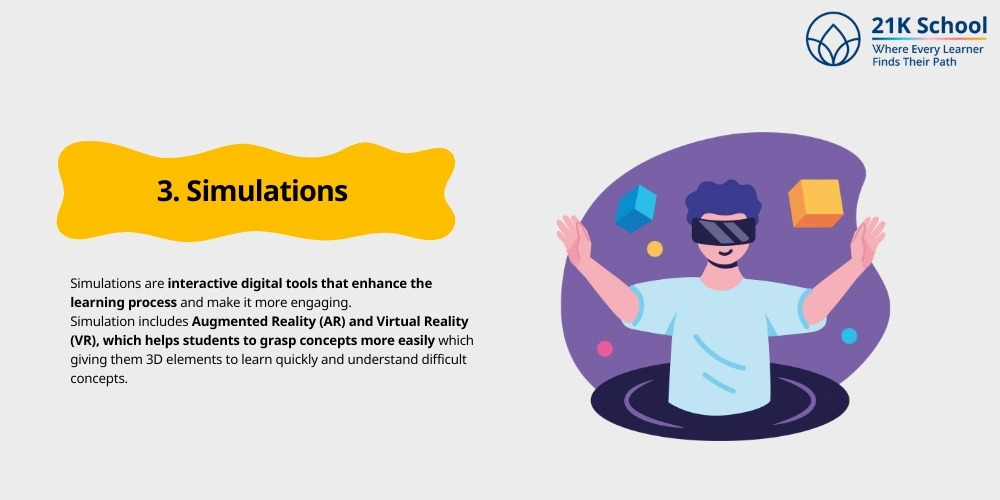
Simulations are interactive digital tools that enhance the learning process and make it more engaging. Including simulation into digital education makes learning easy and enjoyable, which allows individuals to connect with the problems more efficiently.
Simulation includes Augmented Reality (AR) and Virtual Reality (VR), which helps students to grasp concepts more easily which giving them 3D elements to learn quickly and understand difficult concepts.
4. E-learning Platforms
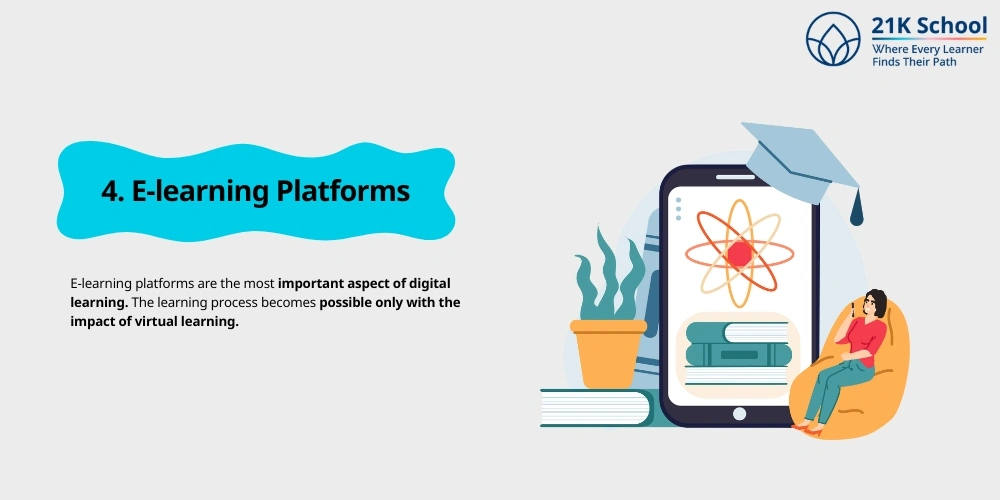
E-learning platforms are the most important aspect of digital learning. The learning process becomes possible only with the impact of virtual learning .
Through e-learning platforms, students can interact with their teachers and peers and can grasp concepts more easily. There are various e-learning platforms such as Zoom, Google Meet, Slack, Microsoft Teams, etc.
5. Learning Management System
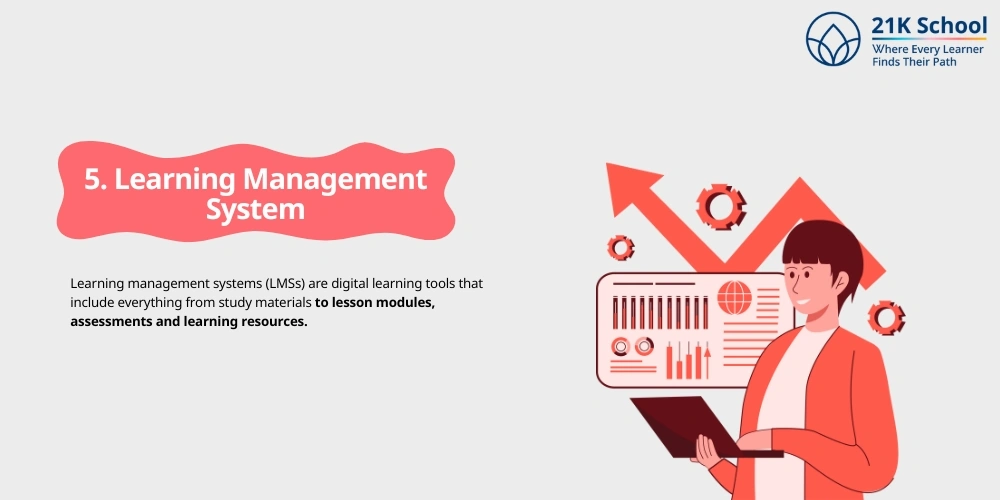
Learning management systems (LMSs) are digital learning tools that include everything from study materials to lesson modules, assessments and learning resources.
According to their needs and comfort level, LMS enables students to understand concepts with ease. Additionally, it helps teachers create class notes and enter data into the learning management system (LMS), which enables them to keep an eye on students’ progress.
6. 3D Elements and Software
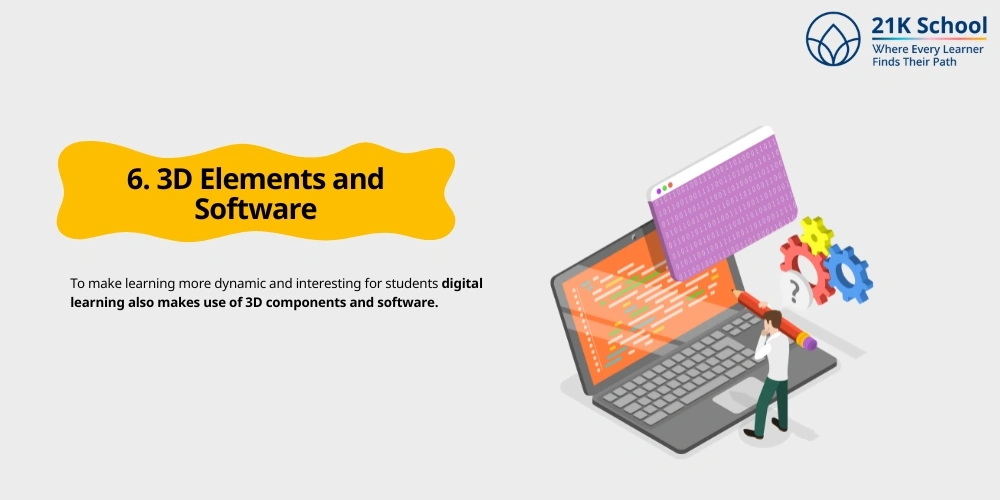
To make learning more dynamic and interesting for students digital learning also makes use of 3D components and software. 3D elements allow students to become more attentive towards digital classrooms .
Students can use a range of software to participate in group discussions, online events, peer-to-peer learning and more.
Wrapping Up
A revolutionary approach to education, digital learning uses technology to produce individualised, flexible, and interactive learning environments.
Through the use of diverse digital tools and platforms, students can participate in gamification, adaptive learning, mobile learning and other activities that improve their comprehension and memory of information.
Digital education has many benefits like cost-effectiveness, accessibility and real-time feedback, but it also has drawbacks like a lack of in-person interaction and technical difficulties.
Digital learning can be made even more effective by addressing these issues with creative solutions.
As technology develops further, digital education has the potential to improve student collaboration and the learning process, opening the door to a more dynamic and inclusive educational environment.

